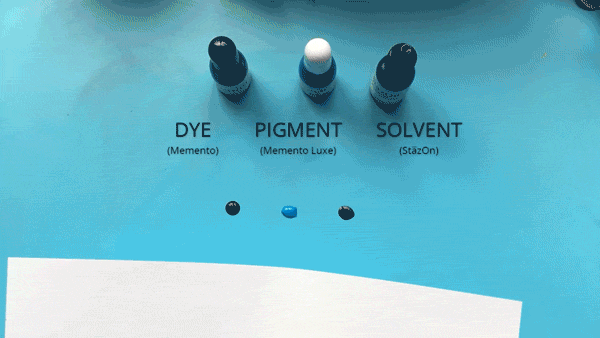That’s a Great Question!
Whether you are just learning to craft, scrapbook, or art journal, or are a seasoned pro, it can still be overwhelming to make buying decisions with all the different products available. There are just so many options! You’ve decided on a project, what your medium is going to be and now you just need some ink—but you find out that too is complex. Often there is no exact right or wrong between different inks therefore choosing which one can seem overwhelming. Here’s some information about the different inks you will find to hopefully help you know what inks you might need for your projects!
We break it down into three types of ink: dye ink, pigment ink, and solvent ink. Most of the varieties offered for papercrafters are dye and pigment inks, but sometimes solvent inks are just what you need, plus they work great for glass, metal and ceramics as well. In building your knowledge, it is best to know how each type of ink behaves to determine what option you need to achieve your project’s desired result.

A white piece of text paper is laid across three puddles of ink, one dye, one pigment and a solvent ink. The dye and solvent inks absorb into the paper while the pigment ink does not.
Dye Inks
Dye inks are made up of a water-based solution and a soluble dye. Soluble means they mix in to the water like sugar in tea. Dye inks soak into paper, dry quickly, and usually have a bright translucent appearance. Picture the dye inks bleeding down into the paper and coloring the paper fibers. It is similar to how food coloring blends into food. The quick drying time can be an asset as you can stamp a card and place it in an envelope without worry of smearing or staining. They can also be used much like watercolor paints and be blended and softened by adding water to the ink or pre-wetting your paper. Dye ink fades a bit over time, particularly in direct sunlight. This is why dye inks have non-visible palette cases—a super easy way to distinguish from the pigment inks at the craft store. Our lines of dye inks include Memento, Kaleidacolor, Fireworks! Sprays and Walnut Inks. Ink Potion No. 9 is a popular blending solution often used with dye inks.

Watercolor paper was sprayed down with Ink Potion No. 9 before sweeping Memento Summer Sky across it. A wet brush was used to watercolor some Memento Pear Tart along the bottom edge. Memento Love Letter inkpad used with a cute kite stamp, while Kaleidacolor in Spectrum was stippled across the left, and the word “Fly” was written on with Memento Dual Tip Marker.
Pigment Ink
Pigment inks are also water-based, but with suspended pigment. It is more like when you try to mix sugar crystals into iced tea. Pigment inks lay on top of the paper, dry slowly and usually have a lush appearance. It acts much the same way acrylic paint does, coating a surface rather than soaking in. Pigment inks can do justice to your project by creating a dense, painted appearance. Pigment inks can have different appearances from a chalk-like matte finish, to pearlescent or super shiny metallics. It is also great for use with embossing powders since they do not dry right away. However, if you are not embossing be sure to allow for enough drying time before laying other items or colors on top. Nothing can be more heartbreaking to feel you created the perfect card then accidentally smudging it at the last minute. We offer many types of pigment inks including Brilliance, Delicata, Encore!, Fabrico Markers, Memento Luxe, Radiant Neon, VersaCraft,VersaColor, VersaFine, VersaMagic, and VersaMark. Embossing Powders are a popular accessory used with pigment inks.

VersaColor in Cyan was used to stamp on glossy paper, as well as VersaFine in OnyxBlack for a calligraphy pen stamp. Brilliance in Sunflower Yellow was stamped on black cardstock, while Black Shimmer Delicata was heat set with Clear Embossing Powder for a shiny ink bottle on a teal punched piece.
Solvent Ink
Solvent inks are similar to dye inks, but instead of water-based are solvent based. Solvent inks dry super fast on paper, but also have staying power with surfaces such as plastic, glass, ceramics, and metal. They are kind of like Sharpie markers. It is common to use solvent ink on paper because the ink will not run with watercolors. Solvent inks are the perfect ink for mason jar projects, decorating cookie tins, and coloring plastic. Solvent inks are an exciting addition to the crafter’s toolkit because it allows a great deal of flexibility. Solvent ink is not compatible with alcohol-based markers like Copic—stick with the water-based inks for that. Make sure you have the proper cleaner for solvent inks to make clean-up worry free. StazOn is our solvent ink line, available in two sizes plus inkers. StazOn All-Purpose Stamp Cleaner will make sure clean-up is a snap.

StazOn in Jet Black was stamped onto white cardstock. Memento ink was then used with a watered brush to watercolor in the letters, which did not effect the stamped image. StazOn in Midnight Blue was used to stamp a dragonfly onto a piece of SHEET metal, while Emerald City StazOn was used on a piece of vellum.
After using all the types of inks, the behavior of the different inks will be apparent in the first couple of projects. Dye, pigment, and solvent inks are formulated differently to provide the most options for your crafting needs. These different ink varieties are to serve you, your project and your creative spirit.
A big thank you to Imagine Crafts for allowing us to share this wonderful article.
A big thank you to Imagine Crafts for allowing us to share this wonderful article.
This article was published on Imagine Crafts blog found here: https://imaginecraftsblog.com/2016/07/18/which-ink-should-i-use-in-my-project/
No comments:
Post a Comment